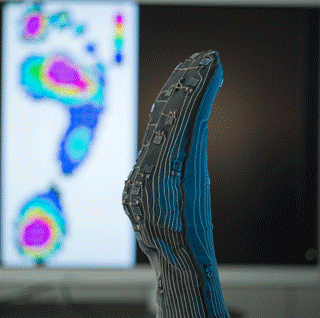May 7 2015
Diabetics often have little feeling in their feet and don’t perceive the body’s pressure or temperature signals there. This can result in unnoticed wounds that then develop into abscesses. Many diabetics have to have toes or feet amputated.
 "Pressure-monitoring stockings with integrated elastomer sensors – trade fair demonstrator without its second, external textile layer.
© Fraunhofer ISC"
"Pressure-monitoring stockings with integrated elastomer sensors – trade fair demonstrator without its second, external textile layer.
© Fraunhofer ISC"
Now, a novel kind of pressure stocking developed by Fraunhofer researchers is set to help protect against wounds via an integrated sensor system that sends a warning when pressure is too high. The new pressure-monitoring stocking prototype will be presented May 19-21 at SENSOR+TEST 2015 in Nuremberg.
Diabetes patients often suffer from nerve and circulation problems in the feet, which reduce their perception of pain. They literally don’t know when it’s time to take the load off their feet. In healthy individuals, the nerve pathways ensure that weight is automatically transferred from one foot to the other during prolonged standing. Diabetics, however, don’t notice that their toes, heels or the balls of their feet are too heavily loaded – the foot receives no relief, and pressure sores may develop unnoticed. Even small uneven areas or shoe pressure can lead to open wounds or damaged tissue on the foot.
In-stocking sensors provide three-dimensional pressure readings
To ensure that poorly healing wounds don’t occur in the first place, researchers at the Fraunhofer Institute for Silicate Research ISC in Würzburg – with support from industry partners and colleagues from the Fraunhofer Institute for Integrated Circuits IIS in Erlangen – have developed a special stocking with integrated sensors. In total, 40 very fine, dielectric elastomer sensors measure compression load and distribution for diabetes patients – taking over the job usually performed by the nerves in their feet. “Existing systems on the market measure the pressure distribution only on the bottom of the foot using shoe inserts. Our sensors are attached to the stocking’s sole, at the heel, the top of the foot and the ankle, so they can take readings in three dimensions. This is a totally new approach,” explains Fraunhofer ISC research scientist Dr. Bernhard Brunner. A pair should cost no more than 250 euros because the measuring system can be cost-effectively manufactured in series.
Electronics transmit data to your smartphone
The sensors are made from a soft and very stretchy elastomer silicone film that is easy to integrate into textiles. This film is coated on both sides with highly flexible electrodes of graphite or carbon black. When the film deforms as a result of compression or stretching, its thickness decreases and its surface area simultaneously increases. This means its capacitance rises with pressure – an effect the ISC researchers can measure. For example, if a patient stands for an extended period in one spot, pressure will build. The sensors can recognize this, and transmit the measurement signal via a conductive thread to a wireless electronics unit developed by researchers at Fraunhofer IIS and consisting of an application-specific integrated circuit (ASIC) chip and a controller. “The unit is designed to record high-resolution readings from up to 40 capacitive sensors across an extremely wide value range,” says Johann Hauer, the Fraunhofer IIS project manager responsible for the project. The ASIC collects the measurement data and the controller transmits it wirelessly to a smartphone or tablet, which then informs the diabetes patient that it is time to change foot position or weight distribution.
“With the current prototype, the electronics are attached to the end of the stocking. We’re planning to relocate them to a small, button-sized housing that can be detached with a hook-and-loop fastening strip. There’s no way around this until a reliable method for cleaning the electronics is developed,” says Brunner. The sensors, on the other hand, have to be resistant to water and detergent. “The first washability tests are in planning, but cleaning using disinfectant is no problem,” says Brunner.
The sensors are either stitched or glued between two layers of fabric, which makes the stockings more comfortable to put on or take off. The stockings themselves are made from a blend of cotton and synthetic fibers. Brunner points out that the fabric is by necessity breathable, moisture wicking and extremely comfortable to wear. “This is important, since the wearer will need to wear them daily.” The range of potential applications is broad – for instance, the textile could be used in sports and fitness. Joggers could use the integrated sensor stockings to analyze their running style and foot positioning. The researchers have already filed a patent application for the pressure-monitoring stockings, and will be presenting their prototype from May 19-21 at the SENSOR+TEST 2015 Measurement Fair in Nuremberg (Hall 12, Booth 537).